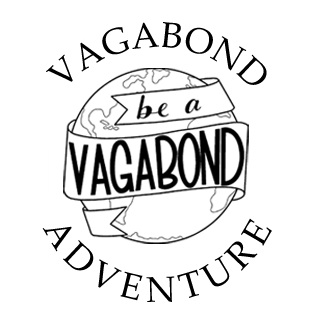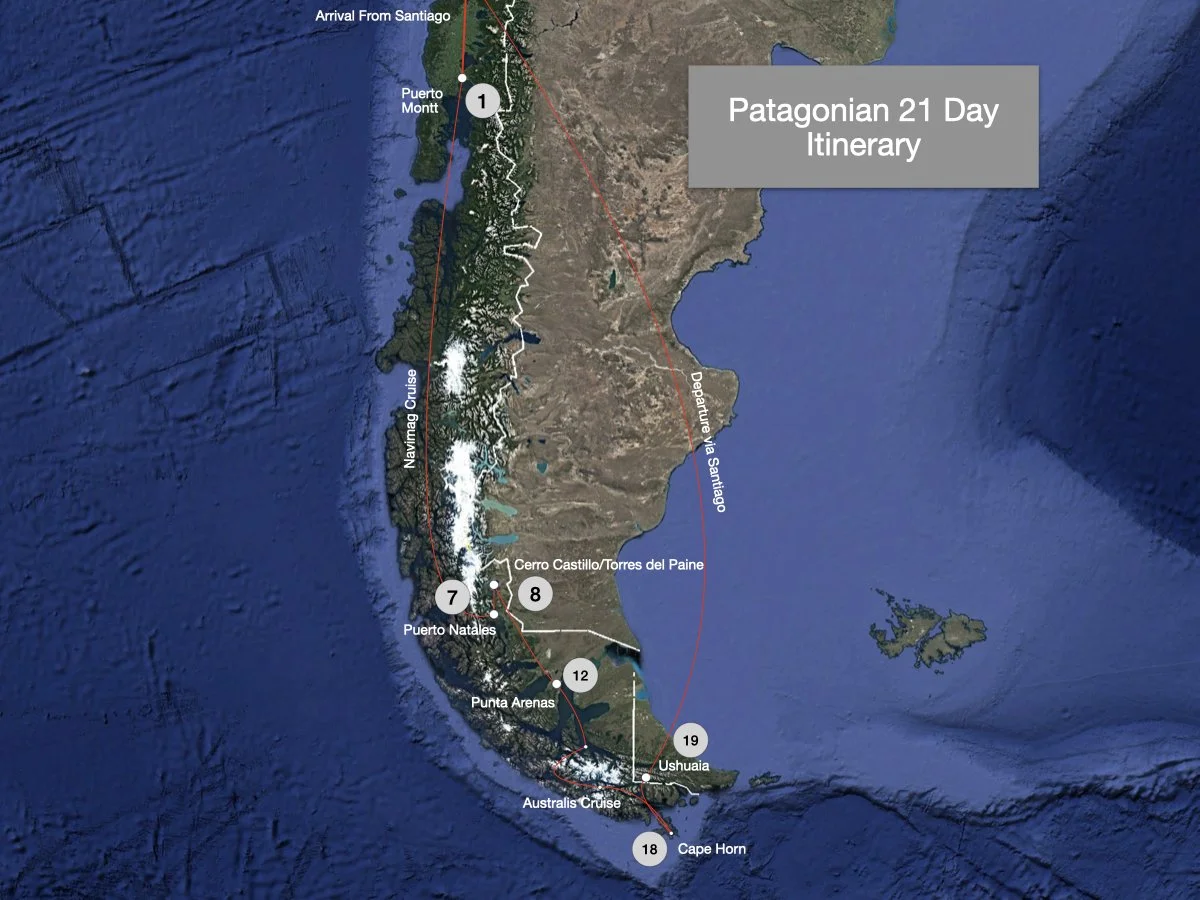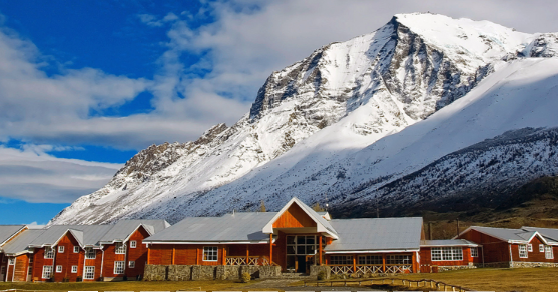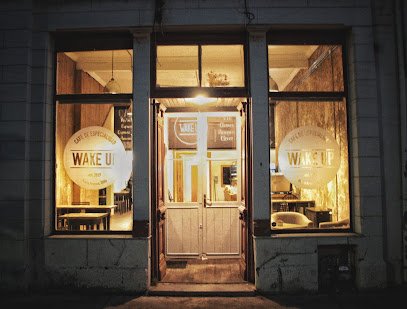A Perfect Three Week Patagonian Itinerary
By Chip Walter and Eric Ruben
This page includes affiliate links. Vagabond Adventure will earn a commission if you make a purchase through one of these links, at no cost to you. Thanks for helping to support us!
A Complete Guide
Overview
Patagonia covers more than 1,000,000 square kilometers. That’s larger than Ontario, larger than Egypt, and twice as large as Spain or California. So getting around can require some planning.
There are plenty of ways to go. Author and novelist Bruce Chatwin famously spent six months hiking and thumbing his way southbound from Lima, Peru. The British explorer and writer Lady Florence Dixiesrated in Ushuaia (Before it was known as Ushuaia) and headed northeast. I spent four weeks traveling from Puerto Montt to Ushuaia by way of Tierra del Fuego and Cape Horn. If you’re planing to explore, you probably need a good three weeks to really do the trip justice, and buy some time to relax.
If you’re arriving from outside South America, the most common entry to the continent into Ushuaia by air via Buenos Aires. That’s the southern route. Arrival in Santiago, Chile is also a good option. From there you come into Patagonia from the North by way of Puerto Montt or San Carlos de Barioloche, regarded as the gateway to Patagonia.
Once in Puerto Montt, you can journey by sea (including the Navimag ferry — recommended) or by land (car or bus). Train service in Chilean Patagonia is essentially non-existent. The options are not much better in Argentinian Patagonia, where only the Tren Patagónico operates, serving a small region in the north from Viedma to Bariloche - a route with hours long views of endless steppes. Fans of Paul Theroux will recognize this route in The Old Patagonian Express. In Argentina, long distance commuter service arrives courtesy of the many buses which are generally fast and affordable. We recommend Andes Mar in Chile or check Busbud.com for a selection in both countries.
The best option might be a car rental, except car rental agencies in Chile and Argentina don’t play nice and charge high fees for crossing the two countries. Drop off fees are prohibitive or non-existent. Just do your homework. If you drive within either of the two countries, the highway systems are extensive and generally well maintained, except in rural areas. Adventurers should select an unlimited mileage plan and make sure you have contact info in case a car breaks down. Mine came to a dead stop outside of Torres del Paine when we found the rattling from the ruts had decoupled our battery cable. (Details of that misadventure here.)
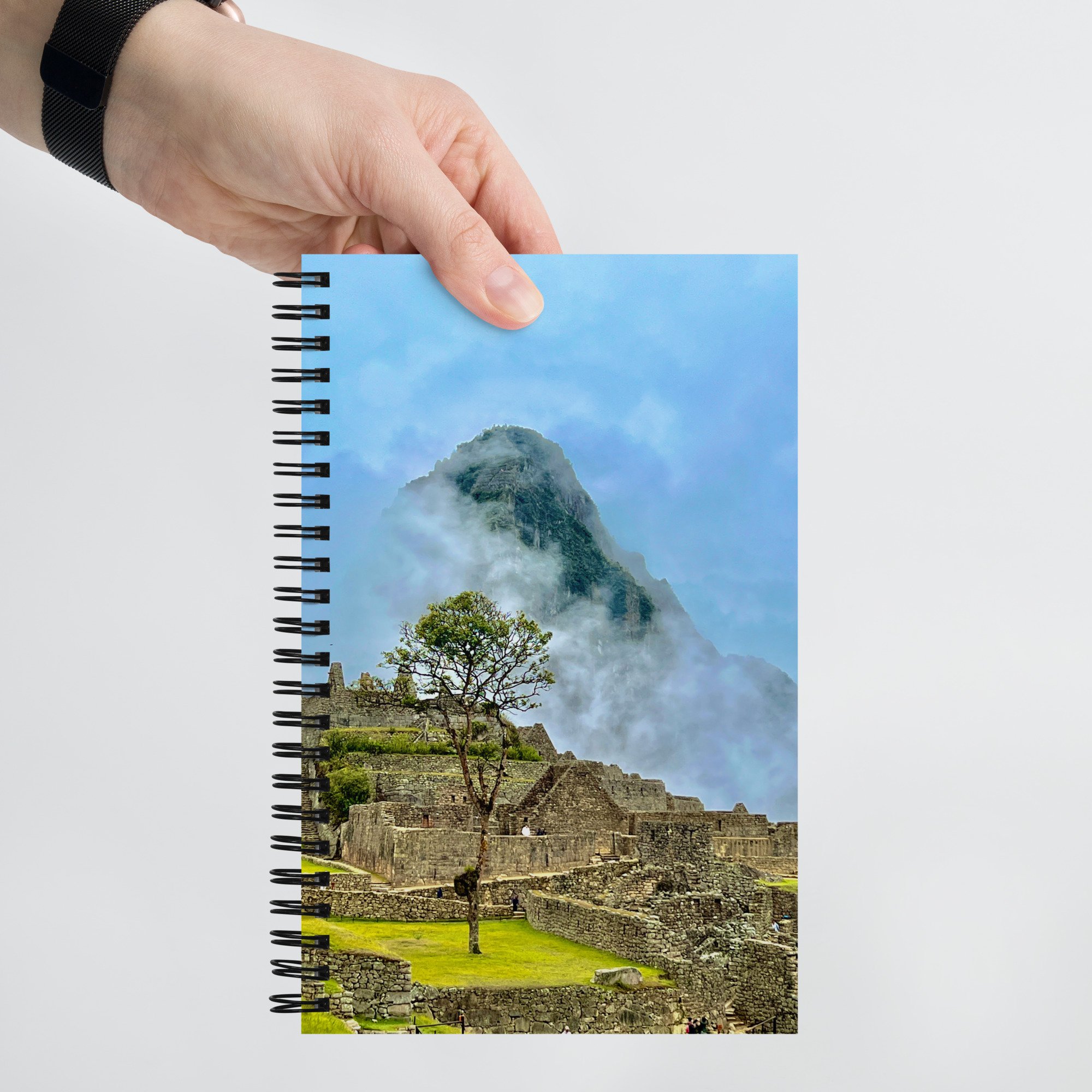
|
Jot your own notes, thoughts, and recommendations in this beautiful Machu Picchu Spiral Traveler's Journal. Available in our store. |

|
Jot your own notes, thoughts, and recommendations in this beautiful Machu Picchu Spiral Traveler's Journal. Available in our store. |
A Patagonian Itinerary
A Navimag sunset. (Photo - Chip Walter)
There are many entry points to Patagonia. Those who want to begin in the heart of Tierra del Fuego start in Ushuaia or Punta Arenas. Puerto Montt is also popular. For this adventure, we begin in Santiago, Chile and then head to Puerto Montt.
(Note: These ideas here are based on our own travel adventure through Patagonia. Your experience will differ. Some amenities and travel options may have changed by the time you begin your own planning. Travel days here are estimated and subject to unexpected events. Please take time to do your own research in advance and stay flexible. Happy travels!)
Day 0. Arrive in South America via Santiago.
Day 1 - 2. Arrive in Puerto Montt. Fly to Puerto Montt from Santiago. Enjoy a day in Puerto Montt.
Days 3 - 6. Ride the Navimag to Puerto Natales. The ferry carries you through hundreds of miles of the most remote territory in the world, offering remarkable views of Patagonia’s stunning archipelagos.
Day 7. Enjoy a day in Puerto Natales. Natales still has a frontier feel, but constantly upgrading as the tourist industry prospers. Take a hike above the Laguna Sofia Patagon and visit the Milodon cave.
Day 8. Drive to Cerro Castillo. Cerro Castillo mostly operates as a border crossing for Argentina and a gateway to Torres del Paine, but if your timing is right, you can catch one of the great horse festivals, called “Jineteadas,” presented one weekend per month through the summer. Flexible itineraries might consider a diversion across the border to see Glaciar Perito Moreno in Los Glaciares National Park. Budget 2-3 extra days.
Day 9 - 11. Visit Torres del Paine. Depending on how much time you have and how inspired you are, Torres can be a couple days or a couple weeks, or months! There are opportunities for hiking, horseback riding, kayaking, and more.
Days 12 - 13. Visit Punta Arenas, the capital of Chile’s Magallanes region and the most populous city in Southern Chile. You can get there by bus or car within a couple of hours. Take a walk through the city and visit the Cementerio Municipal, Nao Victoria Museo, and Parque del Estrecho de Magallanes. There is also a massive casino.
Days 14 - 18. Explore Tierra del Fuego on Australis Cruise. Sail through the channels beginning in Punta Arenas among the islands on the way to Cape Horn, the southernmost land not in Antarctica. Enjoy hiking, incredible glaciers, and waterfalls that thunder into the sea. This is the land that made names like Magellan, Fitzroy and Darwin famous.
Days 19 - 20. Explore Ushuaia. The Australis expedition stops in Ushuaia, the final stop on this adventure. The southernmost city in the world is a fine place to reflect on an epic three week adventure. Plan some time for Tierra del Fuego National Park and take the End of the World train. Tickets available in the center of town.
Day 21. Fly to Santiago. Depart South America with memories of a lifetime.
Bonus. Travelers who can’t get enough and want to sneak in a couple of extra days might think about exploring San Carlos de Bariloche and the surrounding areas on their way out. Bariloche is the main tourist region of Argentinian Patagonia. Catch a flight from Ushuaia to enjoy the mountains, rivers, and the endless hikes. Take a side trip by car to Butch Cassidy’s ranch in Cholila. Read how I found the famous outlaw’s ranch here.
Itinerary Map
The recommended itinerary, by day and location. Transit route between locations is approximate. Day counts are estimated. Stay flexible to accommodate unexpected events.
Read more about great locations, travel planning and expeditions throughout Patagonia in our article in 10 Great Ways to Experience Patagonia.
Travel Planning and Logistics
When to Travel
In Southern Patagonia, the temperatures can reach as high as a crisp 45°F in the summer. Although, there is a winter culture to enjoy, most visitors prefer the summer months. The tourist season begins in the late October spring and extends through the summer, ending around March. You can avoid what crowds there are by traveling “on the shoulder” during spring or fall, but the weather will be less predictable.
Choosing a Guide or Travel Service
Adept travelers can do well managing by themselves, but guide can really help, especially if you don’t speak much Spanish. They can also help arrange visits to remote locations, or hiking/outdoor excursions, kayaking, horseback riding etc. There are not many guides. I worked with Luciano Galvez Martinez. He is local, extremely knowledgeable, speaks multiple languages fluently and in my experience absolutely honest.
Expenses
Thanks to its remote location and its popularity as a destination, Patagonia can be more expensive than most other places in South America, but that doesn’t necessarily mean costs are outrageous. Lodging and food come in at about the same cost as you would find in the United States. Budget carefully for transportation. The Australis (Ventus) voyage is not cheap, but it is exceptional. Navimag costs about the same as a hotel with food for four nights would cost. That’s quite reasonable considering the experience you get in return. Rental vehicles are another option for travel through this part of the region, but schedule ahead because cars can be hard to find and, therefore, expensive. The cost for excursions will vary depending on visitor preferences. Fortunately, scenery is free. We recommend these, or working with Luciano.
Gratuities? In Patagonia, 10% will suffice for a job well done.
Communicating
Non-spanish speakers might have some trouble in rural and out of the way areas, but should have little trouble managing in the bigger cities, popular tourist areas or the various cruises where english is widely spoken. Still, it wouldn’t hurt to buff up on your basic exchanges for transactions and transportation.
Telecommunications
Cell service is sometimes very slow or nonexistent. Don’t expect service in the remote areas. Internet services will be acceptable, but generally slower than the United States, in the good hotels.
The Patagonian Winds
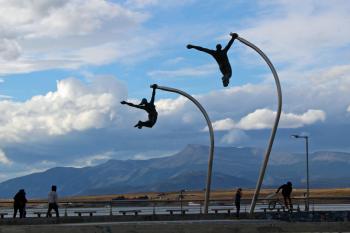
With hardly any land mass in the southern hemisphere, there is little buttress against the stiff westerlies that ransack the bottom of the world. These winds are omnipresent and relentless. They can, and will, blow you over at sea level and elevation. These are the winds that saw Magellan and his peers cross vast stretches of ocean on either side of the continent. As with any expedition, dress carefully. Pack for the wind, and heed the warning signs:
precaucion zona de fuertes vientos!
… If you get the chance, and need further evidence of the role played by Zephyros, visit the Monument to the Wind in Puerto Natales (above).

|
Meet your new go-to pullover for colder weather. Its fleece inside will keep you warm even against those Patagonian winds. On sale - only $29.95 Vagabonds Favor the Bold Unisex fleece pullover |

|
Meet your new go-to pullover for colder weather. Its fleece inside will keep you warm even against those Patagonian winds. On sale - only $29.95 Vagabonds Favor the Bold Unisex fleece pullover |
Places to Lodge
Capturing Patagonia is an active affair. Comfort while immersing in Patagonian delights is critical to a memorable adventure. Here are just a few suggestions to relieve the stress at the end of a long day. Find many more recommendations here.
Hotel Cabaña del Lago Puerto Varas - Puerto Montt. This full service spa and lakefront hotel is a great upscale lodging option, particularly for those travelers about to spend the next several days on Navimag heading into the heart of Patagonia. Located in Puerto Varas, 10 miles from Puerto Montt.
Kau Lodge - Puerto Natales. This charming little hotel sits right on the water, but easily within walking distance of town. This is a great place if you want to be in the mountains with great views of the day and night skies. It’s worth putting up with the trickling water.
Hotel Lago Gray - Torres del Paine. Great service and stunning views make this 4-star lodge a winner. From the hotel you can catch the views of the great spires of Torres del Paine, Gray Lake and Gray Glacier. The restaurant is first class.
Hosteria del Torres. Photo from torresdelpaine.com
Hosteria del Torres - Torres del Paine. This hosteria comes with all inclusive options. They offer horseback riding, vehicles, and guides. The restaurant is quite good!
Hosteria Restaurante America - Ushuaia. Located near the geographic center of Ushuaia, the Hosteria offers clean, mid-line service and is near the airport. The meals are excellent and if you chat up the chef just right, you might get a little extra with your meal. (He made me popcorn because he know I have an addiction.)
Hotel Albatros - Ushuaia. The Albatros is a great stop, located in front of the Beagle channel and ships heading to Antarctica. The hotel has a spa, concierge services, and an excellent restaurant.
Dining
Along with its breathtaking natural wonders, the food is good, sometimes spectacular. Here is a small selection of some additional recommendations based on personal experience. For even more, visit our Patagonian recommendations. We’re always updating.
Kau Lodge - Puerto Natales. A good lodging option as mentioned above. Comes with a top notch service and a cozy coffee-shop/restaurant to fuel up in the morning. The breakfasts are excellent.
The Wake Up Cafe in Punta Arenas. Quirky and delicious.
Wake Up Cafe - Punta Arenas. A top-notch, quirky eatery, excellent for breakfasts and their delicious pastries.
Okusa Restaurant and Emporio - Punta Arenas. Rustic charm and delicious Chilean food. Okusa looks like a cross between a London pub and local bodega. Offers a local menu and a wide selection of wine.
Mesita Grande - Punta Arenas. An Italian-Patagonian fusion specializing in pizza. The guanaco with arugula is a treat that visitors might find intriguing.
La Parrilla Restaurant - Ushuaia. This big, vaulted eatery is famous for its lamb, the torsos of which are stretched like textiles over metal grids that stand beside the open fire in the front window. Rated one of the best Argentine restaurants in the city.
Kalma Restaurante - Ushuaia. High end dining with an eclectic and creative menu that seems to change daily. Kalma applies the concept of environmental cuisine where the ingredients are the product of Tierra del Fuego. Reservations recommended.

|
So beautiful it deserved to be resurrected. On sale - only $2.99 'Twas the Night Before Christmas - 1912 Classic Edition. |

|
So beautiful it deserved to be resurrected. A classic edition of Clement Clarke Moore’s famous poem, celebrating its 200th anniversary this year. Digital edition on sale - only $2.99 'Twas the Night Before Christmas - 1912 Classic Edition. |
Explore Further
Read about the extensive travels of my Vagabond-Adventure through Patagonia in the Vagabond Journal then follow our journey around the world traveling all seven continents.
For more suggestions, including additional information about the services and experiences throughout Patagonia, visit our Patagonian Recommendations. Recommendations are updated frequently. Leave any questions in the comments below or contact the Vagabond-Adventure to learn more.
Bottom Line
Patagonia is a land that inspires, revitalizes, and leaves an indelible mark on anyone who ventures there. Its charm lies in its raw, untamed beauty and its ability to awaken a sense of wonder within each visitor. So pack your bags, leave the world’s noise behind, and head to Patagonia. You won’t regret it. While you’re on your way, enjoy these two inspiring books about the region: Bruce Chatwin’s In Patagonia and Paul Theroux’s The Old Patagonian Express.
